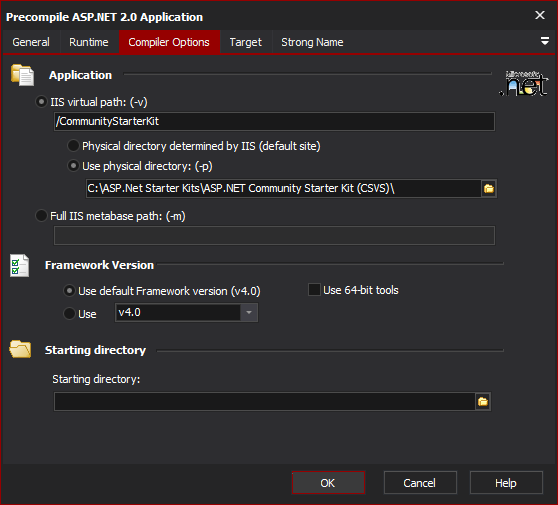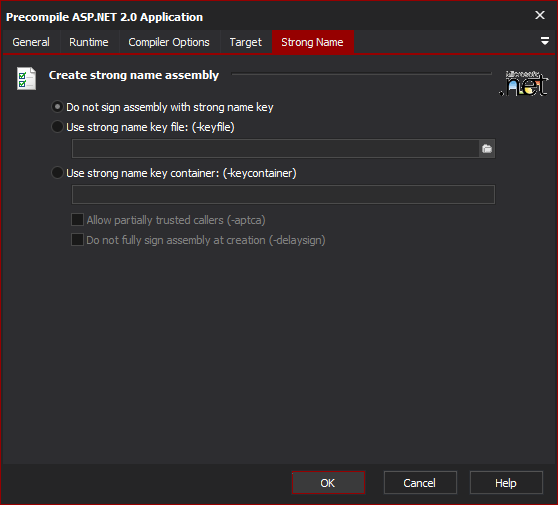Precompile ASP.NET 2.0 Application Action
The ASP.NET Precompiler action allows you to compile ASP.NET applications before deployment.
Precompiling has two main advantages:
- The ASP application does not need to be compiled when first accessed.
- By deploying only compiled ASP applications, the ASPX source files do not need to be in an IIS virtual directory.
Compiler Options

Application
There are three ways to specify the path to your ASP.NET Application:
IIS virtual path with physical directory determined by IIS
The application will be located by using the IIS metabase and the default website. The physical (local) folder will be determined via the IIS metabase.
IIS virtual path with using physical directory
The application will be compiled from the specified physical (local) directory, but as if it was installed at the IIS virtual directory given by the path. This is useful if you want to compile your ASP.NET application from one (offline) directory, but deploy the assemblies in another directory.
Full IIS metabase path
The application will be located by using a full IIS metabase path. The physical (local) folder will be determined via the IIS metabase.
Framework Version
Use default Framework version (vX.X) / Use vX.X
Allows the selection of the .NET version to use for the tool. The minimum is .NET v2.0.
Use 64-bit tools
This options specifies as whether to force the usage of 64-bit tools on a 64-bit system or not. As Automise is currently a 32-bit application it will default to running the 32-bit version on a 64-bit system. Check this option if you require the 64-bit version to be run.
Starting Directory
Starting Directory
The directory that the precompile will be based in. If not set then its the currently working directory of the build.
Target

Target Output Directory
Compile the application in-place
The application will compile to the same directory as the source.
Fully rebuild target application
All sources will be rebuilt, not just those which have changed.
Compile the application to target directory
The application will compile to the specified target directory. Compiling to a target directory automatically implies "fully rebuild target application."
Create updatable application
The compiled application will be updatable.
Overwrite the target directory
If the target directory already exists, its contents will be overwritten.
Emit debug information
The compiler will emit debug information to the log during the compile process.
Use fixed names for compiled assemblies
The compiled assemblies will be given fixed names. If this option is not set, the names will be automatically generated.
Show error stack if fails to compile
Specify if a stack trace is required in the action output when a failure occurs.
Strong Name

Create Strong Name Assembly
Do not sign assembly with strong name
Choose not to sign the assemblies with a strong name. This means that weak naming is required to reference any assemblies created.
Use strong name key file
The filename which has the public/private key pair to be used in generating the strong name.
Use strong name key container
The name of the container which has the public/private key pair to be used in generating the strong name.
Allow partially trusted callers
This allows the produced code to be accessed by partially trusted callers.
Do not fully sign assembly at creation
Specifies that the assembly should only be signed with the public key token rather than the public/private key pair. The produced code can be run before signing is completed. Take great care that no malicious users can access before signing has been completed.